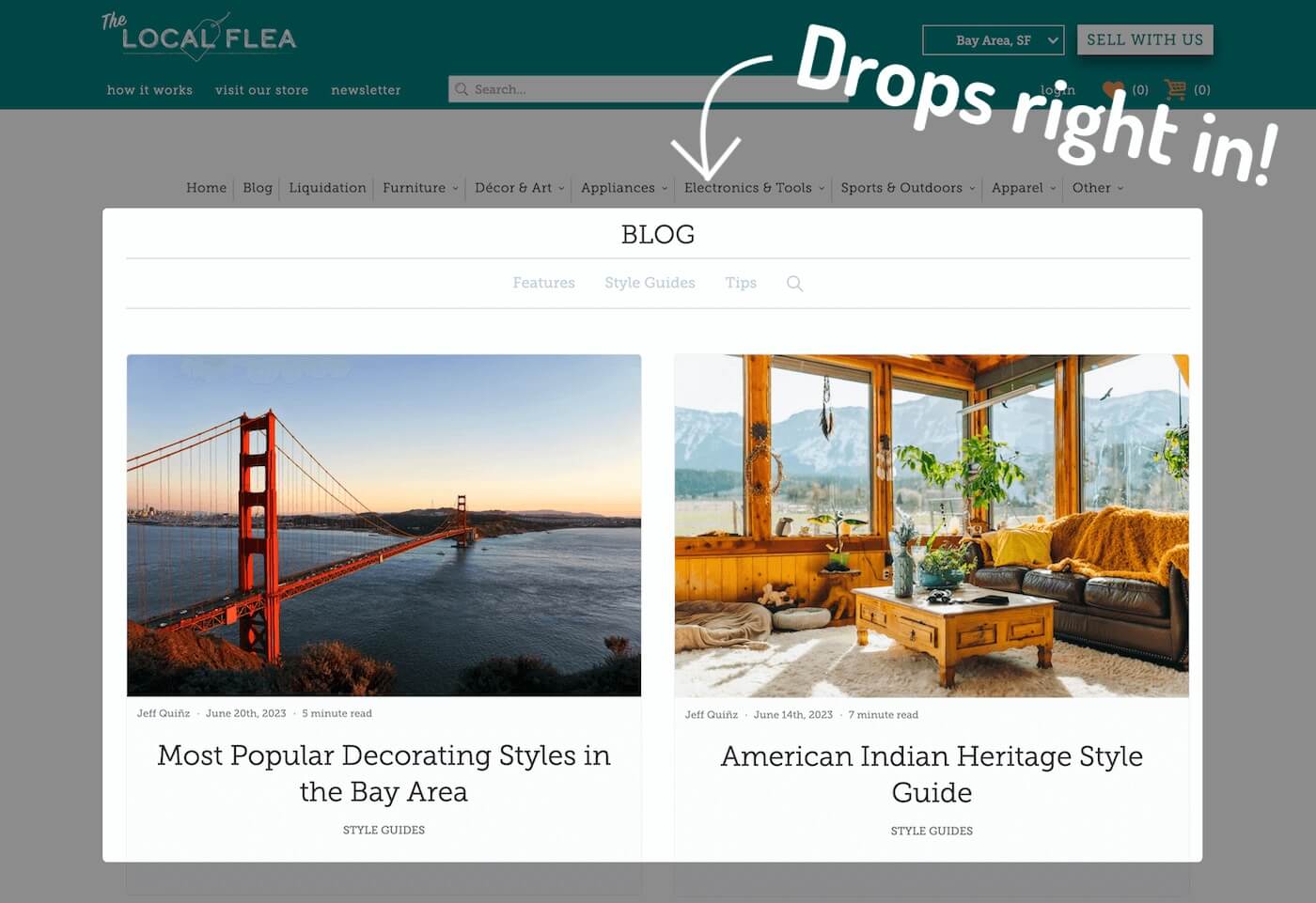ThriveCart and SamCart are both pretty similar, so which is the better e-commerce platform? As their names suggest, they’re both primarily shopping cart builders that enable you to create cart/sales pages optimized for conversion.
Taking this into account, a ThriveCart vs. SamCart comparison makes perfect sense. Since these two platforms’ main focus is on the same thing, they’re real competitors, so comparing them can really help any entrepreneur searching for a specialized shopping cart and/or sales page builder.

Still, no matter how similar, ThriveCart and SamCart do have unique features that make them different not just from each other but from the rest of the similar e-commerce software solutions. What are these features? How crucial are they when choosing between the two platforms?
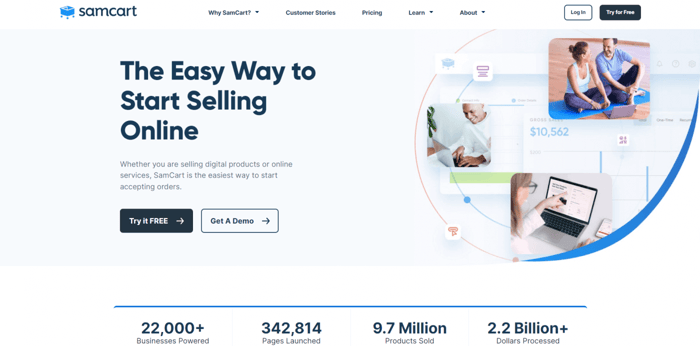
These are some of the questions that we’ll try to answer in the following sections. So, get ready, and let’s explore the worlds of ThriveCart and SamCart together.
Table of Contents
Price
| ThriveCart | SamCart | |
| Pricing: | $495 Standard, $690 Pro One time payment | $39, $79, $159 per month Billed annually |
| Free Trial: | No | Yes |
| Membership Feature: | No | Yes |
| A/B Split Testing: | Yes | Yes |
| Affiliate Programs: | Yes | Yes |
| Page Builder: | Drag-and-drop builder | Drag-and-drop builder |
| Design and Customization: | Good, but slightly basic; Conversion-optimized page templates | More advanced and intuitive; Very customizable page templates |
ThriveCart Pricing Options
Scarcity of Information
To us, ThriveCart is a little bit odd in this regard. We’ve tried so many different business solution platforms out there. Usually, finding clear information on the platform’s pricing plans – presented on a separate page just for that – is a breeze. That’s not the case with ThriveCart.
For starters, there’s no separate page on the ThriveCart official site where you can see the platform’s pricing plans and learn how much they cost and what they include. There’s no separate pricing plan entry in the ThriveCart support center either.
The only pricing plan-related information we found there is about the benefits of the platform’s Pro offering, and that’s about it. No mention of any other plan or, for that matter, anything else that’s related to the company’s pricing system.
ThriveCart Pricing System
Nonetheless, if you dig around, this is what you’ll find.
Currently, ThriveCart offers two pricing plans: ThriveCart Standard and ThriveCart Pro.
The regular price of ThriveCart Standard is $495 – this is not a monthly or annual fee but a one-time payment, which means lifetime access to ThriveCart.
- Some of the features the ThriveCart Standard plan includes are:
- Unlimited checkouts and carts
- Split-testing
- Subscription management
- Abandoned cart recovery
- One-click upsells and order bumps
- Drag-and-drop page builder and conversion-optimized page templates
- The regular price of the ThriveCart Cart Pro plan is $690 – a one-time fee.
- Some important features the ThriveCart Pro plan includes that are missing from the Standard plan are the following:
- The ability to connect to a custom domain
- A possibility to start your own affiliate program
- A subscription saver
- Sales tax calculation
No Free Trial
The biggest possible downside to the ThriveCart pricing system is that it doesn’t include a free trial. However, once you decide between the two plans mentioned above, you can get a full refund if you contact ThriveCart and cancel your subscription within 30 days after signup.
Still, it can be pretty deterring to pay $500 or $600 just to take ThriveCart for a spin. Most users are already used to getting limited free access to similar platforms, so we can’t say this was the best move on ThriveCart’s part.
Lifetime ThriveCart Access
On the other hand, the greatest advantage is the lifetime access you get to ThriveCart for fairly low prices.
Whichever plan you choose, you need to pay just once, and that’s it; no recurrent costs, no monthly or yearly fees, no subscription extension, or anything along those lines. You’ll enjoy the perks of ThriveCart forever. ThriveCart claims that there’s no other similar platform that offers anything along these lines, and it’s right.
Paying the plan fees upfront may seem like a lot. However, considering that you’re paying only once for “forever-access” to ThriveCart, the pricing plan fees look ridiculously low, especially compared to other e-commerce solutions. The only tricky part is figuring out whether ThriveCart would really work as your primary weapon of choice or not.
The SamCart Pricing System
Three Standard Pricing Plans
Unlike ThriveCart, SamCart does have a separate pricing page where you can find the most important information on its pricing system laid out clearly.
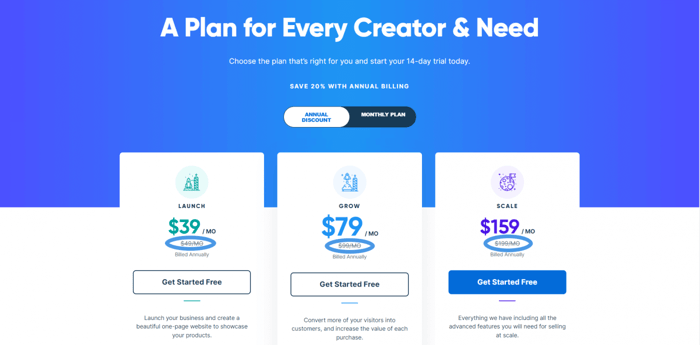
This image shows the fees for the three standard SamCart pricing plans billed both annually and monthly (we’ve circled the monthly numbers in blue). As indicated in the image, there’s a significant difference between the monthly and annual plans.
With an annual plan, in addition to the clear price advantage, you get other perks as well, such as a one-on-one launch support call with the Grow plan or dedicated SamCart expert support with the Scale plan.
The Standard Plan Features
There are so many interesting and noteworthy features that the three standard pricing plans include, but we’ll limit our list to only a few of the most notable:
- Launch:
- Unlimited products, pages, courses, and memberships
- Intuitive drag-and-drop page builder and customizable page templates
- Flexible customer billing options, the most interesting being the “Pay What You Want” one
- Smart pixel tracking
- Grow:
- White-label branding
- Post-order upsells and order bump collections
- Subscription charge reminders
- Email customization
- Priority support
- Scale:
- Subscription saver
- Abandoned cart recovery
- Split-testing
- Your own affiliate center/program
The Enterprise Offering
In addition to the three standard plans, there’s also a custom enterprise offering appropriately called Enterprise. It seems that there’s no fixed pricing for this plan; the only way to find out how SamCart defines its price would be to contact the sales team.
The Enterprise Plan Features
Some of the Enterprise plan’s unique features worth mentioning are:
- Custom reporting
- Multiple sub-accounts
- Dedicated account manager
- Technical setup support
- Product roadmap prioritization
Is There a Free Trial?
In contrast to ThriveCart, SamCart does offer a 14-day free trial, typical for the majority of e-commerce software solutions.
Is SamCart’s Pricing Justified?
When comparing the price difference between ThriveCart vs. SamCart, clearly, SamCart is a bit pricey, especially considering its highest-tier plan. Besides, it doesn’t offer the tools that let you build and run a full-fledged e-commerce store like Shopify does, for instance.
Nevertheless, SamCart intentionally chooses not to be an e-commerce store builder, and many customers feel like the high prices are justified. Considering its level of complexity and the prices of some other popular e-commerce solutions, such as Keap (Infusionsoft) and ClickFunnels, this may very well be true.
Features
| ThriveCart | SamCart | |
| Abandoned Cart Recovery: | Yes | Yes |
| A/B Split Testing: | Yes | Yes |
| Multiple Pricing Options: | Yes | Yes |
| Coupons and Discounts: | Yes | Yes |
| Subscription Saver: | Yes | Yes |
| Sales Funnels: | Yes | No |
| Prediction Engine: | Yes | No |
| Test Mode: | Yes | No |
| Advanced Editing Features: | No | Yes |
| One-Click Upsell Funnel: | No | Yes |
| Course Building and Hosting Ability: | No | Yes |
Some Common E-Commerce Features
Considering ThriveCart vs. SamCart, they are pretty similar, so it shouldn’t come as a surprise that they have a lot of features in common. These features may be implemented slightly differently in each e-commerce platform, but they’ll still perform the same function.
We won’t get into too much detail in this subsection. Instead, we’ll just name several notable e-commerce features found on both platforms. The following list shows some of the important e-commerce tools shared by ThriveCart and SamCart:
- Abandoned cart recovery
- Subscription saver (also known as dunning)
- Ability to offer multiple pricing options to your customers (such as one-time payment, subscription, split pay, and the most flexible “Pay What You Want“ option)
- Order bump offers
- One-click upsells
- Coupons and discounts
- A/B split-testing
In the following two subsections, we’ll go over some more tools and discuss how they’re implemented in ThriveCart and SamCart. As you’ll see, some of them are not strictly e-commerce tools.
There’s already a lot of content out there focusing on the fundamental features of these two platforms. Therefore, we decided to elaborate on the ones that may be overlooked but really define and set the platforms apart, especially in the case of ThriveCart.
ThriveCart
The Visual Editor and Design Templates
ThriveCart offers a drag-and-drop editor where you can build and edit your carts, sales pages, and checkouts. It includes the usual features that you would expect from an e-commerce drag-and-drop page builder/editor, such as:
- Adding text, images, videos, custom HTML blocks, countdown timers, buy links, heading, and other content blocks.
- Customizing colors, font size, spacing, line height, etc.
ThriveCart doesn’t offer anything akin to a standard library of predesigned page templates when it comes to design.
Instead, it provides you with four different customizable design types that can serve as a basis for building your cart or other types of pages. They literally function like blueprints, giving you the fundamental structure of your cart page, but you need to insert details and customize them to your liking.
In that sense, it’s neither a blank canvas nor a typical design template; rather, it’s somewhere in between.

The ThriveCart design types are already optimized for conversion, but the platform doesn’t stop there. It incessantly tests and improves them in step with the new market changes and the challenges those changes pose to contemporary e-commerce entrepreneurs and enthusiasts.
In addition to the out-of-the-box design types, the platform allows you to import third-party designs or copy existing page designs that you have access to.
Sales Funnels
ThriveCart claims that it allows you to create sales funnels, which it really does. However, don’t expect the elaborate, sophisticated funnels you can build in ClickFunnels. Still, a sales funnel is a sales funnel, so let’s look at how this feature works in ThriveCart.
A ThriveCart sales funnel essentially consists of the following:
- A page where you promote and sell your main product.
- An upsell – a new page where you offer an upsell, i.e., additional product as an upgrade to the basic purchase.
- A downsell – shown to the customer if they decline the upsell offer.
- Another upsell page that presents the customer with a new upsell offer.
- A success page – the funnel’s closing page, which shows information about the total purchases the customer has made.
This is how a ThriveCart sales funnel usually looks, but remember that the platform allows you to add up to five upsells and downsells (presumably, as alternatives to declined upsells).
Business Analytics and the ThriveCart Specialized Prediction Engine
In the analytics context, ThriveCart and SamCart offer more or less the same options for checking stats such as sales, profits, and so on.
For instance, you can see the numbers related to your sales in a year, month, week, day, custom period, etc. One might prefer the analytics dashboard on one of the platforms to the other, but that’s hardly a big difference that can be considered a deal-breaker.
However, one feature sets ThriveCart apart from SamCart and other similar platforms: its prediction engine. Based on how it works, we can infer that it’s a machine learning-based tool.
Therefore, the prediction engine learns the specifics of your business from your earlier and current data. It then makes informed and intelligent predictions about how your business will perform in the future in terms of numbers and stats. This can be extremely useful and play an important role in your efforts to improve your business.
First, it can show you what reasonable expectations are regarding your business development in the future. Second, it can help you identify the variables that contribute to the positive and negative business outcomes with reasonable certainty, allowing you to concentrate more on certain facets of your business and make necessary adjustments for the better.
The Test Mode
A very interesting e-commerce feature that ThriveCart has is the ability to switch your product’s status to a test mode. What does this mean?
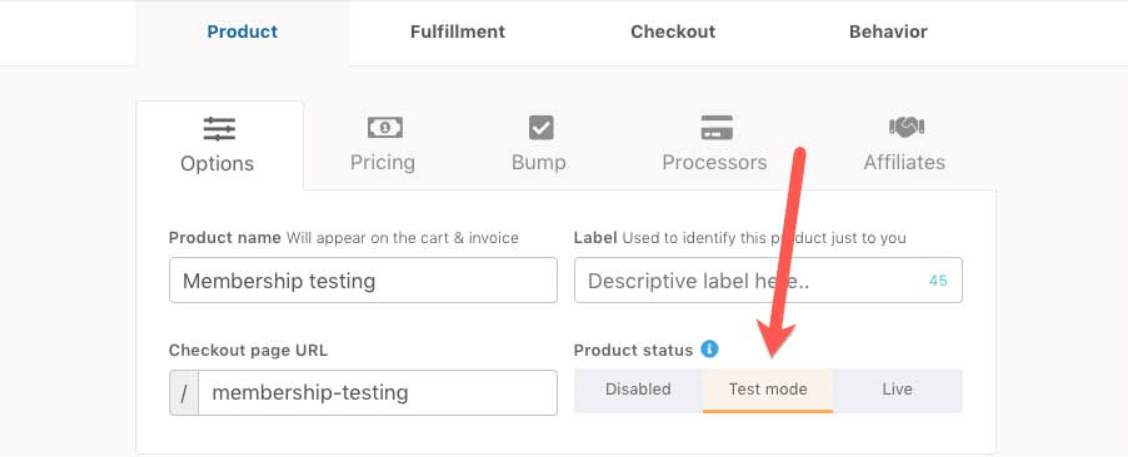
The test mode enables you to monitor in isolation how everything related to your product, from the front-end to the autoresponder, works in practice. The isolation part means that you actually exclude your product from the regular everyday traffic. More precisely, it means that you won’t be able to receive payments while testing your product.
Then, why do the testing at all?
The short answer is that it allows you to experience your product as well as the entire sales process from the perspective of your customers, which can be extremely insightful.
The test mode allows you to see how well everything related to the sales and marketing process works (including added integrations), make necessary adjustments in case something doesn’t function as expected, and work more effectively on creating a superb user experience.
It’s worth noting this is a feature that you’ll find in the SamCart feature set as well.
The Affiliate Program
ThriveCart has a very generous affiliate program in place where it pays 50% commissions to its affiliates per every new signup they’re responsible for. All you need is a ThriveCart account and an official application for the program.
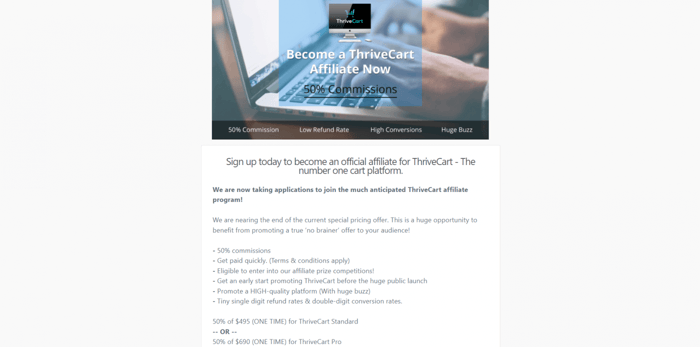
It’s not just ThriveCart itself that can benefit from an affiliate program. That’s why the platform allows its customers to start their own affiliate campaigns as well. When starting an affiliate program, you can control and customize multiple aspects of it:
- Define the affiliate commissions.
- Automate the affiliate payouts.
- Set affiliate options like the affiliate URL link and the specifics for the signup process.
- Track how well your affiliates perform in a separate affiliate analytics dashboard, etc.
Keep in mind that the affiliate program is an option only if you subscribe to the ThriveCart Pro plan.
SamCart
The Page Builder and Templates
The SamCart page builder/editor is a drag-and-drop interface where you can build and customize your sales/checkout pages. Frankly, not much that separates it from the ThriveCart visual editor/builder, so there’s not much to say about it that wasn’t already said about ThriveCart.
At the risk of repeating ourselves, the SamCart builder also allows you to add and edit different content blocks and elements of your page:
- Headlines
- Dividers
- Images
- Videos
- Tabs
- Custom HTML blocks
- Social proof sections
- Text
- Spacing
- Colors, etc.
Editing a page element is a breeze; just click on the part you want to edit. The editor will show you all the customization possibilities related to the specific aspect of the element you want to modify.
When it comes to the overall look and feel of the page builders/editors, in our subjective opinion, though both are easy to use, intuitive, and simple, we find the SamCart one to be a bit cleaner and more elegant. Here’s how it looks:

As far as design and templates are concerned, SamCart offers more regarding numbers and aesthetics than ThriveCart. In our opinion, the SamCart predesigned page templates look aesthetically pleasing and professional. This is a part of what you’ll find in SamCart’s library of templates:
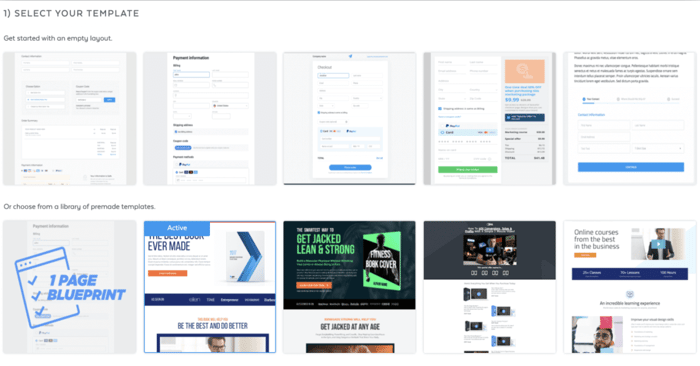
It goes without saying that all SamCart templates follow the current design and e-commerce standards, which means that they’re mobile-friendly and easily customizable.
SamCart’s One-Click Upsell Funnels
Despite not being primarily a funnel builder, just like ThriveCart, SamCart also allows you to create a funnel-like experience. SamCart calls it a one-click upsell funnel, the “one-click” part indicating that it only takes one click for your customer to add more products to their order. How does this work?
Essentially, it’s the same as in ThriveCart. SamCart allows you to create upsell pages, downsell pages, and a thank you page.
You connect the upsell/downsell pages with certain products, and voila – you’ve got yourself a sales funnel. You’re free to add two, three, or more upsells/downsells to your original offer.
On Creating Unique Sales Funnels
However, what’s more interesting to us is the ability to create a pretty unique (so to speak) non-classic sales funnel. What makes it unique and non-classic?
One of the characteristic features of SamCart is that it unifies the sales and checkout experience by including the checkout on the sales pages.
This is one of those features that makes SamCart stand out from the bulk of the other e-commerce solutions. But what you can have on just one page doesn’t end with including a checkout form.
SamCart allows everything related to your customers’ buying experience – an original offer, social proof, a checkout form, an upsell, and so on – to be placed on the same page. In that sense, a SamCart sales page can function the way an entire sales funnel functions.
Multi-Page vs. One-Page Funnels
The obvious difference is that classic sales funnels are multi-step, i.e., multi-page entities, while SamCart offers a similar experience as a one-page entity. We intentionally use the term “similar” because a one-page funnel makes for a simpler, more focused, and maybe a bit more convenient buying experience.
With a one-page funnel, users don’t have to go through multiple steps and navigate through many new offers, i.e., upsells and downsells (which can be pretty daunting) – like in the picture below – just to complete their purchase.
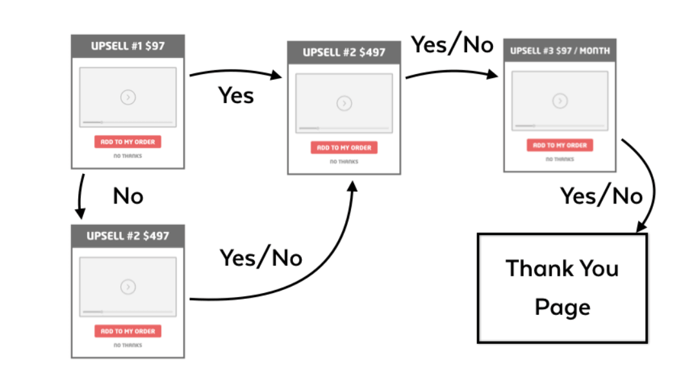
In many cases, the main offer and just one upsell or order bump will do. This way, you’ll still get a chance to sell more than one product, but without overwhelming your customers with a stack of additional offers they didn’t even anticipate.
SamCart as a Digital Product E-Commerce Platform
Just like with ThriveCart, you can sell both digital and physical products on SamCart. Nonetheless, SamCart might generally be better than ThriveCart for the first group of products.
It’s not so much that ThriveCart lags behind SamCart in terms of strictly e-commerce features that allow you to promote and sell digital products; it’s that SamCart caters specifically to course and content creators as well as digital product sellers. It provides the tools necessary for building and hosting courses and other digital products.
In short, SamCart helps you unify your selling experience with your creating experience (by doing both on the same platform), and it makes everything more convenient if your business revolves around digital goods.
The Courses App
Speaking of digital products, one of SamCart’s best selling points is its course-building and hosting capability. This can appeal to a wider array of people and attract many content creators who are looking for an alternative to existing course-building platforms like Kajabi, Teachable, LearnWorlds, and Podia.
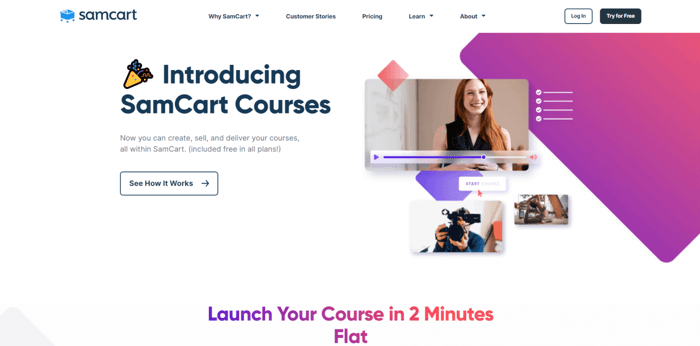
The place to build your courses in SamCart is its Courses App.
The Courses App is a fairly recent addition to the SamCart feature set. According to one of SamCart’s co-founders Brian Moran, many successful course and coaching program creators whose products were hosted on Kajabi used SamCart for their sales/checkout pages.
Our guess is that SamCart probably thought it would be a good idea to complement its existing toolkit with a course builder, so it developed the Courses App.
The Courses App allows you to use multiple types of files (audio, video, images, and text) and build regular and drip content courses. Along with the course creation tools, SamCart provides you with sales page templates designed specifically with course creators in mind.
This, together with features like student management tools, automation, quizzes, and the SamCart native auto-enroll technology, can put you well on your way to success.
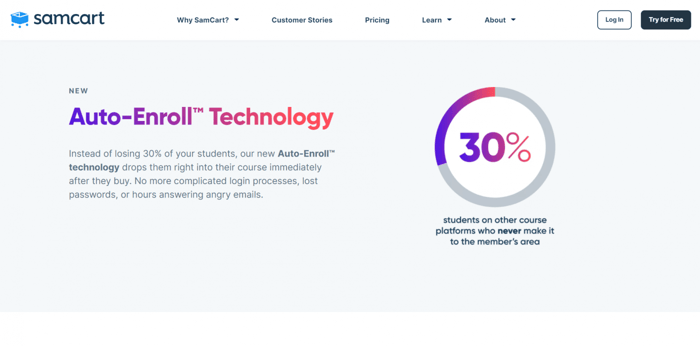
SamCart’s Affiliate Center
On top of using SamCart as your e-commerce solution of choice, you can use its official affiliate program as an additional revenue stream. It’s very detailed, so it deserves its own section.
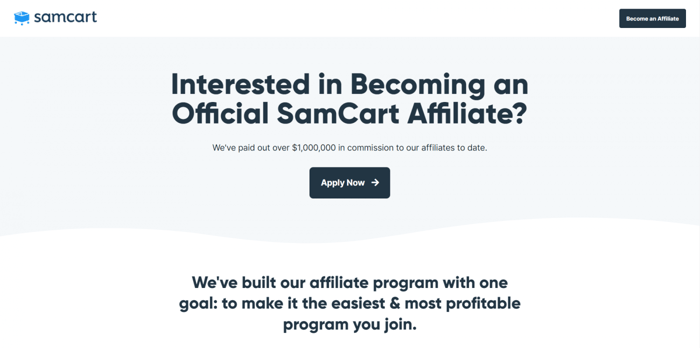
Preconditions
SamCart makes it extremely easy for you to apply for affiliate status; the only recommended (but not required) precondition you must fulfill is having a certain following in the community of business owners.
A larger community of followers can give you a significant head start, but SamCart encourages you to apply for its affiliate program even if you don’t have a la
